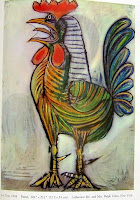Animal Project "Amigo"

My students just love drawing dogs, for this project I use a work by Ron Burns as our inspiration. Ron is known for his colorful dog portraits. Ron begins each portrait with the eyes. "Their eyes hold nothing back, whether it's love or fear, heartbreak or admiration. Every portrait begins with the eyes, they have to because from there all the life and personality radiates outward," he says. In our lesson we are inspired by Ron’s painting “Amigo”. We focus color and space, I encourage the students to have fun with the color. We use sketching pencils, and oil pastels or mediums such as acrylic paint to create our work of art. Step #1: Draw light guidelines across the center and down the middle of the page. Draw a egg shaped oval for the head. Step #2: Draw the dogs eyes and snout. Step #3: Now draw his large ears. Step #4: Draw the body as shown below. Step #5: Draw the floor and add your own details. Step #6: Finish your colorful dog and have some f...



